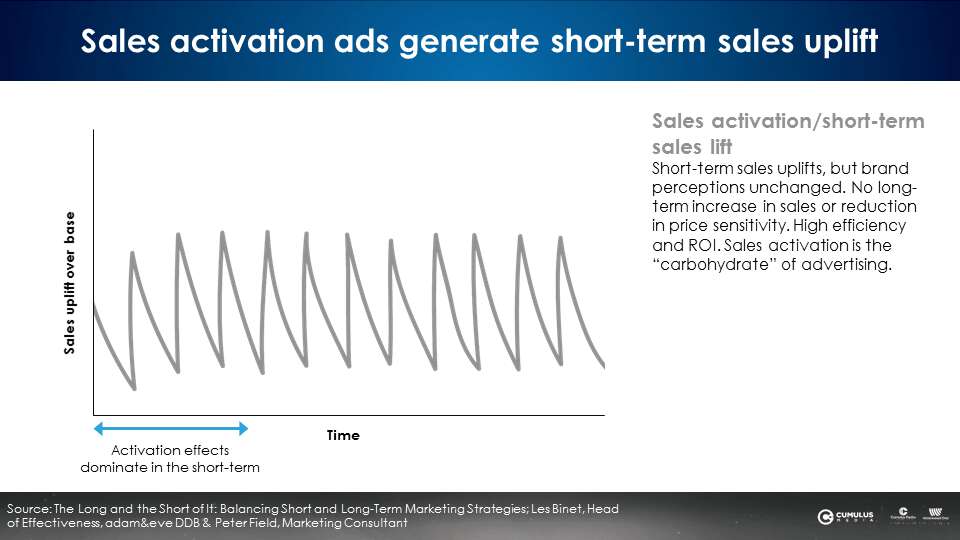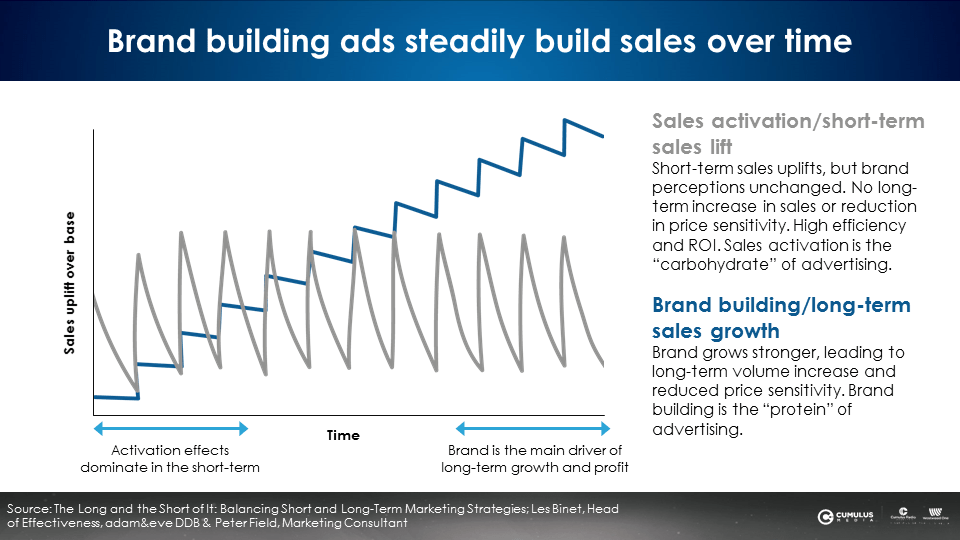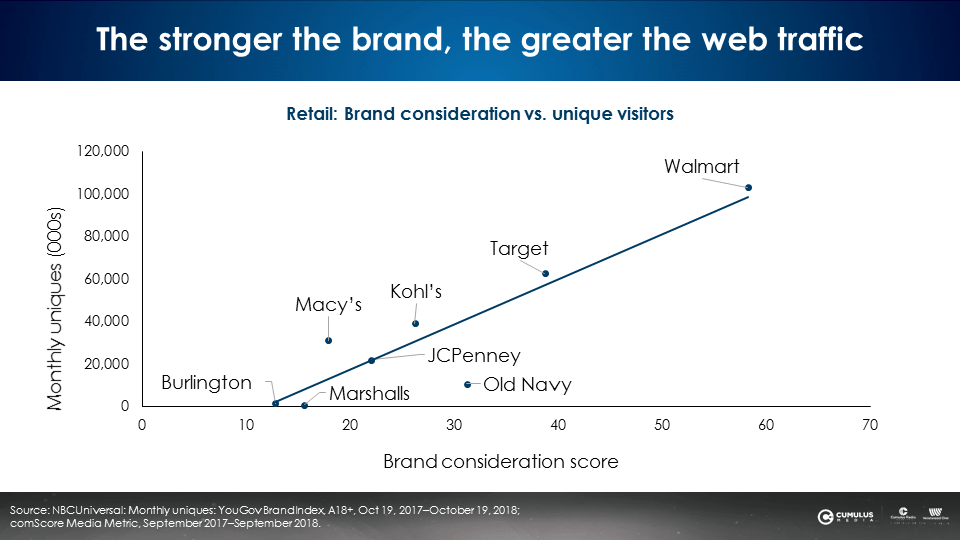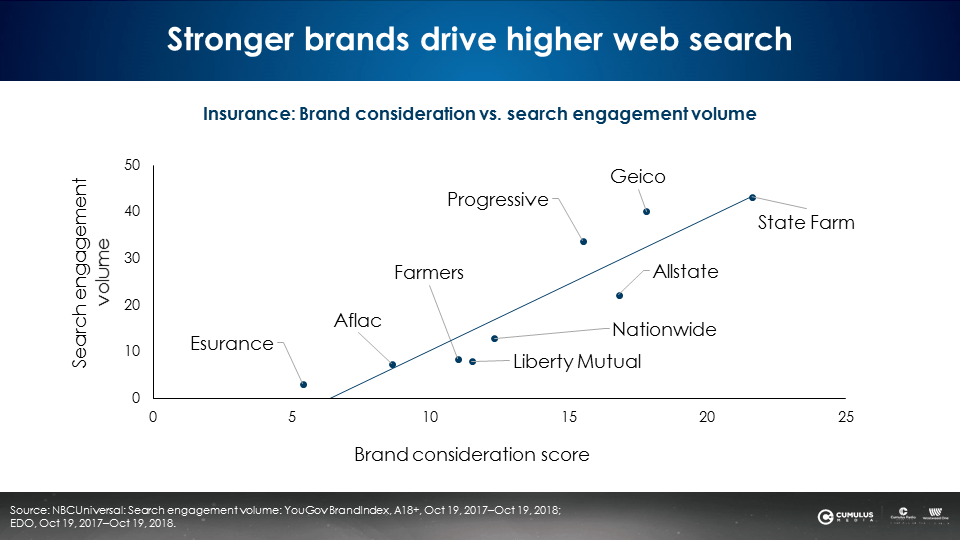Brand Building Campaigns: The Secret To Growing Site Traffic And Search Volume
There are two types of advertising campaigns to create impact: sales activation campaigns and brand building campaigns. What’s the difference?
Sales activation campaigns: the “carbs of advertising”
Les Binet and Peter Field, the godfathers of marketing effectiveness, explain that the goal of sales activation “is to focus on people who are likely to buy in the very near future. That means exploiting existing brand equity to generate sales right now.”
Sales activation features rational copy and tight targeting. In their book Media in Focus: Marketing Effectiveness in the Digital Era, Binet and Field report that “activation effects are relatively easy to measure, because they tend to be big, immediate and direct. In the short term (six months or less) they tend to produce the biggest sales responses.”
Binet and Field show how sales activation campaigns generate sales uplift through a series of short-term sales spikes that quickly collapse.

Sales activation campaigns decay fast and don’t build long-term sales. They are the carbs of advertising: a sugar rush of short-term sales and then a crash.
Brand building campaigns: the “protein of advertising”
Of the two types of campaigns, brand building is harder to achieve, requires greater investment, and is more important. According to Binet and Field, “Brand building means creating mental structures (associations, memories, beliefs, etc.) that will pre-dispose potential customers to choose one brand over another. This is a long-term job involving conditioning consumers…so it takes time; talking to people long before they come to buy.”
Brand building requires mass reach media like television and AM/FM radio. That’s because the goal is to target everyone in the category, even if they are not in the market right now.
Brand building campaigns depend on emotional creative that makes people feel something. Emotional messaging has more impact than rational creative with facts and details that are mostly ignored.
While short-term sales uplifts are smaller, brand building sales effects grow and grow over time, becoming the main driver of long-term growth and profit.

The massive number of marketing effectiveness studies analyzed by Binet and Field reveal the sales effects of brand building “decay away more slowly…in the long run, brand effects are the main driver of growth.” Binet and Field find that the ideal mix of marketing investments should be 60% brand building and 40% sales activation.
Strong retail brands generate more site traffic
The stronger the brand, the greater the digital impact. NBCUniversal compared brand consideration to site traffic for retail brands. The correlation is clear – the stronger the brand, the greater the digital action.

Brand consideration is asked in the following manner: “If you were in the market for X, name the stores you would shop.”
Brand consideration is indicated on the chart left to right. Web traffic to the retailer’s website is shown on the vertical axis.
Brands with low brand consideration have weak site traffic. Brands with high brand consideration have higher website traffic.
Brand building advertising creates name recognition and awareness. Greater name recognition and awareness means more visits to a brand’s website. Brand building requires mass reach media.
Strong insurance brand consideration generates more search volume
The same pattern emerges with insurance brands and web search. On this chart, insurance brand consideration is shown left to right. Search volumes are indicated on the vertical axis.

The stronger the brand, the greater the search volume. The more a brand is known, the more people will search for it. That is why it is so important for advertisers to use the mass reach of AM/FM radio and TV to build their brand.
AM/FM radio makes your digital plan better
The secret to growing site traffic and search volume? Brand building. Growing awareness. Increasing brand consideration. Being known before you are needed.
Key takeaways:
- Sales activation campaigns are the “carbs of advertising,” a sugar rush of short-term sales and then a crash.
- Brand building campaigns are the “protein of advertising,” with sales growth building in the mid to long term.
- Brand building features emotional creative on mass reach media that creates memories and associations.
- Talk to everyone who buys your category. Talk to them regularly. Advertising memories fade.
- Go for reach rather than frequency. Reach as many category buyers as possible.
- Per Binet and Field, the ideal marketing budget allocation is 60% devoted to brand building and 40% for sales activation.
- The stronger the brand, the greater the site traffic and search volume.
Pierre Bouvard is Chief Insights Officer at Cumulus | Westwood One.
Contact the Insights team at CorpMarketing@westwoodone.com.